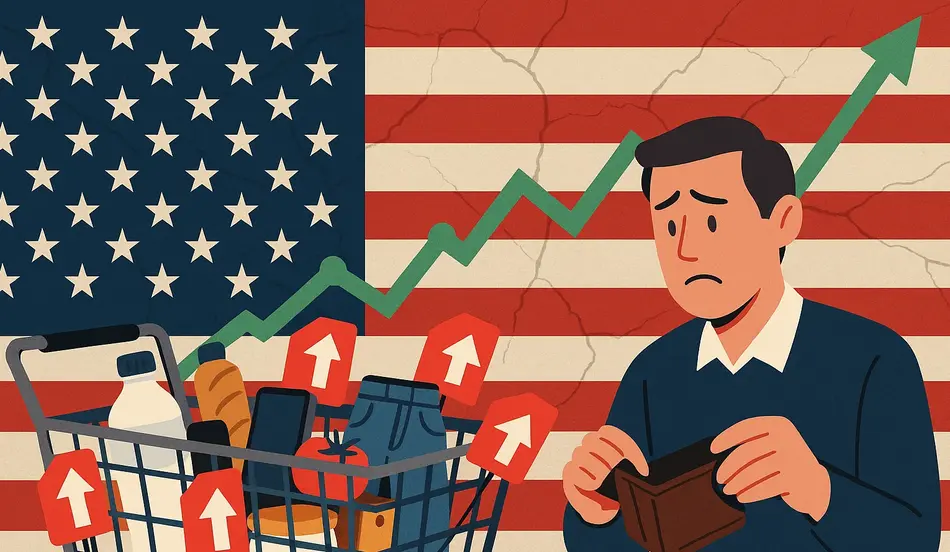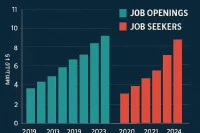Tariffs are once again in the spotlight as U.S. businesses, farmers, and consumers brace for rising costs while Wall Street rallies to record highs. The stock market’s surge—led almost entirely by a handful of technology giants—masks underlying weaknesses in the broader economy, leaving experts divided on what metrics truly reflect America’s economic health.
On Monday, the S&P 500 index crossed 6,500 for the first time, while the Dow Jones Industrial Average and Nasdaq also posted fresh highs. For many casual observers, such headlines suggest economic strength. But beneath the surface, tariffs, shrinking exemptions for imports, and disruptions to trade are squeezing households and small businesses. Economists warn that the stock market is no longer a reliable barometer of prosperity, with only a few companies driving most of the growth.
Tariffs and Their Direct Impact
Tariffs have long been a cornerstone of President Trump’s trade policy. His administration is now ending the longstanding exemption for small shipments valued under $800, which previously allowed American consumers and businesses to import low-cost goods without paying duties. Beginning this week, tariffs will apply even to small purchases, forcing both companies and households to shoulder higher costs.
This change is already visible in sectors like retail and agriculture:
- Farmers report that soaring fertilizer costs, linked to tariffs, are eroding their profits.
- Shoppers are seeing extra fees at the register, with retailers passing along tariff costs that they had previously absorbed.
- Importers now face complex classifications to determine duty rates—for example, instead of simply labeling a shipment “clothing,” businesses must specify detailed categories such as “men’s jacket, 80% wool, 20% linen,” with tariffs ranging as high as 18%.
Bill Cohan, a former Wall Street banker turned journalist, called tariffs “a tax on the American consumer” and warned that corporations cannot indefinitely absorb these costs. “At some point, it’s going to come home to roost,” he said.
Why Markets Keep Rising
Despite these pressures, stock indices remain buoyant. Analysts attribute the surge to a narrow concentration of corporate earnings. A handful of mega-cap technology companies—including Apple, Microsoft, Amazon, Alphabet, Meta, Nvidia, and Tesla—are largely insulated from tariffs and immigration policies. Their strong profits have inflated market valuations, creating what some experts call a “hype cycle.”
“This is just like 2007,” said Cohan. “The markets are in a major hype cycle. Financial channels hype new records every day, Wall Street profits from it, and retail investors pile in. But corrections eventually happen. It may not be today or tomorrow, but history tells us these cycles end.”
Justin Wolfers, an economics and public policy professor at the University of Michigan, offered a more nuanced view. “We can learn some things from markets, but they’re not telling the whole story. When you see seven companies dominating the S&P, that’s not a reflection of the broader U.S. economy.”
Looking to Hire in Finance or Tech?
Post your jobs on WhatJobs and attract top analysts, engineers, and market strategists ready to make an impact.
Post a Job Now →Tariffs Distorting the Data
One difficulty in assessing the true health of the economy is how tariffs distort common indicators. Normally, consumer spending and production move in tandem: when people spend more, businesses produce more. But tariffs disrupt this relationship.
As companies and households rush to purchase goods before tariffs take effect, spending spikes—even if production has not. Once tariffs hit, imports slow, and spending data becomes skewed. Wolfers explained: “What we normally look at—the hard data on spending—gets distorted because people are front-running tariffs. It creates a misleading picture of economic strength.”
This makes forecasting difficult for policymakers and investors. While official data may show resilience, much of it may reflect short-term buying rather than sustained growth.
Public Backlash Against Protectionism
Polling suggests Americans are increasingly skeptical of protectionist policies. Once popular, tariffs now poll two-to-one against the president. Wolfers noted that “Trump may hold the reins of power, but he’s lost the battle of ideas. The public understands tariffs are a tax.”
Indeed, many households are starting to notice higher prices directly. One shopper told Scripps News she paid an additional fee at checkout, labeled as a tariff. For middle- and working-class families already strained by inflation, even small increases in consumer goods add to financial pressure.
The Illusion of Prosperity
Both experts agreed that record-high markets give a misleading impression of prosperity. Cohan emphasized that indices like the S&P 500 or Dow primarily reflect corporate profits, not wages, job growth, or small business health.
“The markets are not the economy,” he said. “They’re a metric for the well-being of the top 10% who own most of the stocks. For everyone else, tariffs are squeezing margins, wages are stagnating, and daily life feels more expensive.”
Wolfers raised another concern: crony capitalism. “When Apple’s CEO can turn up at the White House and influence trade policy, that’s an advantage big corporations have that small businesses do not. Entrepreneurs in a garage don’t get exemptions—they just pay more.”
Investors Still Optimistic
So why are investors not panicking? Cohan suggested it comes down to momentum and psychology. “Nobody rings a bell at the top of the market,” he said. “In 2007, there were small cracks that eventually led to collapse, but people stayed in because no one wants to miss out on the hype.”
Lower interest rates could further fuel stock gains, even as tariffs drag on the real economy. If the Federal Reserve bows to political pressure and cuts rates, corporate borrowing costs will fall, potentially boosting profits and extending the market rally.
Still, history offers warnings. The 2008 financial crisis followed a similar pattern: early signs of strain in mortgage markets went ignored until the system collapsed. Whether tariffs trigger a similar reckoning remains uncertain.
What Comes Next
The immediate impact of ending the $800 import exemption will be felt by small businesses reliant on low-cost goods, as well as by consumers who shop online for foreign products. Over time, economists warn, the cumulative effect of tariffs could slow growth, depress hiring, and reduce investment.
For now, the markets remain disconnected from these realities. As Wolfers concluded: “The stock market reflects corporate profits, not national prosperity. If we want to measure the health of the economy, we need to look at wages, jobs, and consumer well-being—not just record highs in the S&P.”
FAQs
1. Why are tariffs being blamed for higher prices?
Tariffs act as taxes on imported goods. When exemptions end, companies must pay duties on items they previously imported tax-free. Most businesses pass these costs on to consumers, raising prices at checkout.
2. Why is the stock market still rising if tariffs are hurting the economy?
Because only a handful of tech giants—mostly insulated from tariffs—are driving index gains. Their strong earnings overshadow broader economic weakness, creating the illusion of prosperity.
3. What does the $800 import exemption change mean for consumers?
Previously, Americans could import small shipments under $800 without duties. Now, even low-value items like clothing, shoes, or bike parts will face tariffs, raising costs for households and small businesses.
4. Are tariffs popular with the public?
No. Polling shows protectionism is now deeply unpopular, with most Americans recognizing tariffs as a hidden tax. While some support them as a way to protect U.S. industries, the majority say they raise costs without delivering clear benefits.




